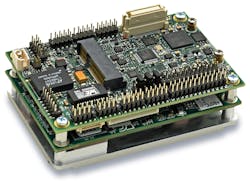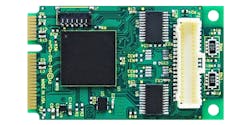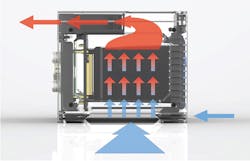Download this article in PDF format.
PC/104 and the ISA bus will never go away, but smaller-form-factor platforms like Diamond Systems’ Zeta system (Fig. 1) are needed to minimize size, weight, and power (SWaP). They also must deliver the performance required for new applications from drones to the latest medical equipment.
1. Diamond Systems’ Zeta board, which uses the COM Express Mini Type 10 form factor, includes features like Mini-PCIe peripheral expansion.
The Zeta boards employ the compact COM Express Mini Type 10 form factor, allowing them to squeeze into small devices. The Mini-PCIe peripheral expansion is becoming more common on small motherboards and computer-on-modules (COMs) because it’s being used for more than adding Wi-Fi to notebooks.
For example, Acces I/O’s mPCIe-DIO-24 is a 24-channel digital I/O with a change-of-state (COS) Mini-PCIe card that would work with the Zeta board (Fig. 2). Size and power requirements are minimized with an FPGA. Other Mini-PCIe cards often have microcontrollers to provide more functionality. In fact, the most challenging facet of Mini-PCIe peripheral cards concerns the connectors. The small size is possible using new, compact connectors and cabling.
2. Acces I/O’s mPCIe-DIO-24 is a 24-channel digital I/O with change-of-state Mini-PCIe card would fit right into the Zeta board.
Curtiss-Wright’s Parvus DuraCOR XD1500 rugged mission computer is an example of how Mini-PCIe cards can be used. The computer hosts an Intel Xeon-D with up to three Mini-PCIe sockets for peripheral expansion.
Compact boards and tiny peripheral expansion options help to reduce size and power requirements, but not so much in terms of weight. Significant amounts of weight in board-level systems are often related to cooling requirements such as conduction cooling.
The VITA 48.8 air-flow cooling standard defines a systems approach that can cut the weight of a system almost in half versus a comparable conduction-cooled system (Fig. 3). The standard uses conventional 3U and 6U VPX boards, but separates them to allow air flow between them instead of having a conduction system move the heat away from the boards. It eliminates a lot of metal, including channel locks, enabling systems to be built using lighter-weight materials such as 3D-printed plastic frames. This can have a significant impact on cost as well lead to more flexible design options.
3. VITA 48.8 defines an air-cooled system that’s half the weight of a comparable conduction-cooled system.
Keep an eye out for systems with hardware designed to support machine-learning (ML) and artificial-intelligence (AI) applications. Platforms like Nvidia’s Jetson TX2 accelerate ML and AI applications using the GPGPU built into the system. Even smaller AI/ML accelerators are showing up in chips like Intel’s Movidius family.
Then there are platforms such as Movidius that target vision processing but can be used for other jobs as well. Intel’s chips are already used in DJI’s drones to provide obstacle avoidance and tracking, as well as recognizing gestures of users when the camera is aimed at them.
Chips like Movidius would fit nicely on a Mini-PCIe card. They’re also small enough to be incorporated onto a motherboard. Quite a few of these platforms are becoming available, and there’s even a RISC-V array of 64-bit ET-Maxion and ET-Minion cores in the works from Esperanto Technologies. The AI/ML platforms are designed to minimize SWaP while bringing significant performance improvements.
Modular, board-level systems remain the best way to quickly incorporate diverse processing and peripherals into an embedded solution. Commercial off-the-shelf (COTS) platforms are diverse and address a wide range of application requirements. Options abound for smaller, more powerful systems, and they can even address the latest trends in AI/ML.





